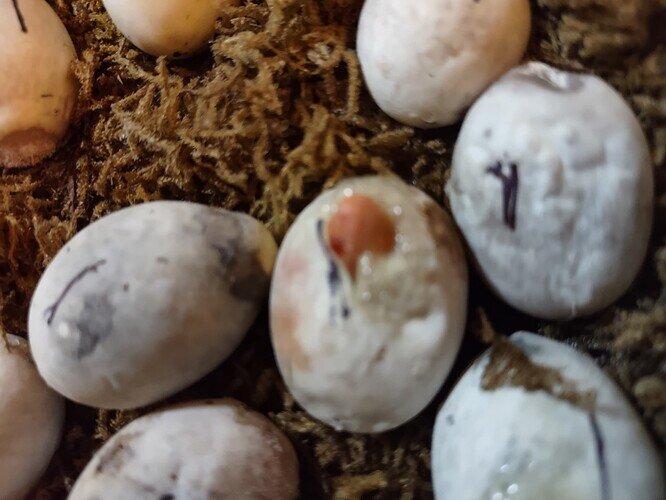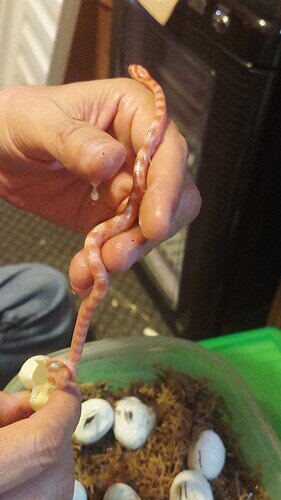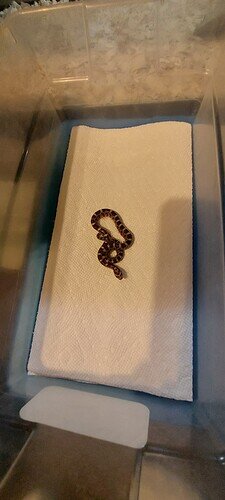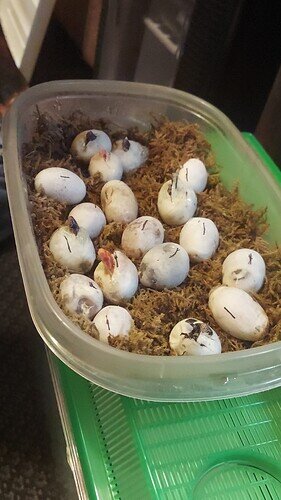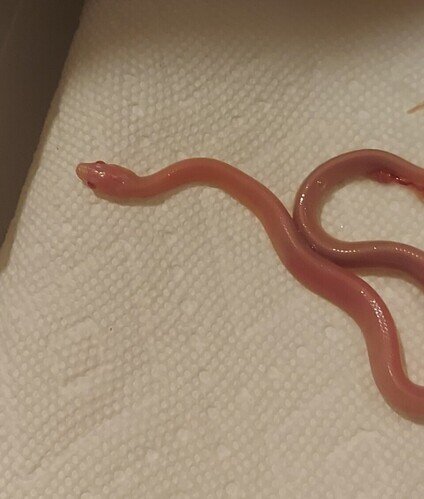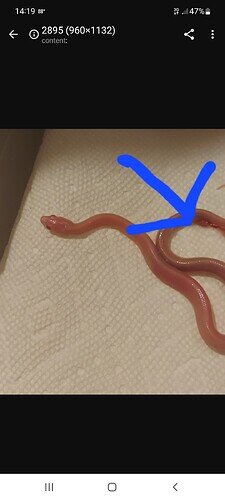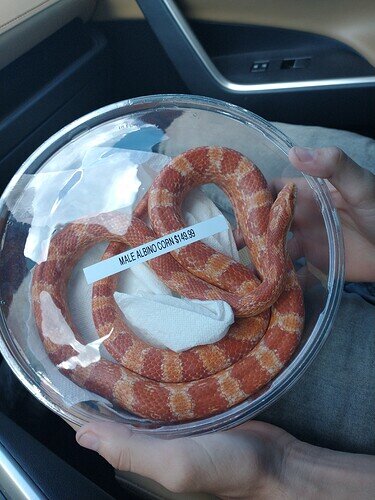I have 25 corn snake eggs in the incubator that are on day 64 at 83⁰. You can clearly see that there are snakes inside the eggs but they aren’t doing anything yet. I thought it was supposed to be a pretty set 60 days to hatch. Is there anything i should do or do i just wait?
Just be patient, they are going to do their own thing and it’s much more likely to cause problems if you do something than if you just trust the process and let them hatch on their own. Eggs can be unpredictable, sometimes they hatch weeks early, sometimes they hatch exactly on schedule, and sometimes they hatch weeks late, there are too many factors to be able to accurately predict it.
Nothing you can really do, unfortunately! They’ll pip when they’re ready. Have you smelled them? I find that they smell a bit like green bell peppers when they’re getting close to hatching.
There is no such thing as set hatch dates. Much like human gestation, even with the same factors, not every baby is born at the same time. They’ll come out when they’re ready.
8 of the eggs have hatched. To my surprise the normal female i bred to my albino male turned out to be het albino and so far half of the hatchlings have been albino.
Welcome to the surprises that come with hatching! I had a similar, “Huh, where did those Amels come from?” this year, but it’s the best kind of surprise you can get, if it’s what you want to work with.
Yes, this is my first year and only have one Snow male, one albino male, one albino female, and what i thought was a normal female that were of breeding age to learn the process of breeding and hatching. I also have a pair of Sunrise and a pair of reverse okeetee, but their eggs were all slugs for some reason this year. It was both of their first year breeding so hopefully next year will go better for them. I don’t think this was the problem but both pairs with slugs were not brumated. Both pairs were purchased this spring and both pairs were born in late 2019.
Seems you really got lucky with that normal, then!
I don’t brumate mine at all, was my first year, and the clutch I did get (I had one catastrophic incident, egg binding that led to surgery/loss of female reproductive capability) only ended up with three total losses (two went bad early on, one a fluke during hatching). My guess is that you likely missed the females’ ovulations and either paired too early or too late. Also possible your males just didn’t perform, which happened to me with the clutch I did get. Only happened because I threw in a spare male at the last moment, as my other made not a single attempt to actually do his job. I am similarly hoping for better results next year. Congrats on the beautiful little ones!
This is my first year so i guess we’ll see, but i think my normal female has multiple hets. The ones that look like normals are actually grey to silver rather than orange to brown in color like the female is. I’m not sure if it’s due to a het or if normals are just born that color and change to orange to brown as they age.
This clutch just continues to surprise me. The female was thought to be normal but so far not a normal in the batch. Got this little guy today. The male was an albino.
Congratulations on getting babies! Healthy babies are always a win. You’ve got some nice surprises, too!
Yep. She does, and so does the male who sired the clutch. That last baby is definitely something different! Hard to tell color in that lighting, as well as before the first shed, but I don’t see any markings. My first thought was “Blizzard” but we’ll be able to tell more after it sheds.
Normal babies aren’t brightly colored when they hatch. They’re usually a kind of nondescript reddish-brownish-greyish. You may see dots of red or orange between saddles, especially toward the head and neck. Again, can’t tell based on these pics but the hatchling in the last pic means that some of your grey hatchlings are Anery or Charcoal.
Again, congratulations on your beautiful babies!
Thanks. Just had another hatch with no marking at all. I have 1 that looks like a possible normal now but the rest look to be anery or charcoal. Also the ones that look to be albino look like possible salmon rather than normal albino like the dad. Every egg that hatches has been a surprise so far. I never expected to have the variety i’m getting. Just expected normal het albino for the entire clutch. It’s been a very exciting weekend since i also got a small litter of albino checkered garters. Only 5 live and 5 slugs from them but the live ones are healthy and already eating chopped night crawlers. Our family has grown by 30 this weekend with 5 more expected to hatch next week.
Very exciting!
I’m not sure about any Salmon though. Salmon usually refers to two copies of Red Factor, which would require both parents to be at least het Red Factor. If they had it, you’d know. It’s one of the few codominant corn snake genes which means it shows when even one copy of the allele is present. There are no hidden copies/ hets of this trait. (Snakes with one copy are usually called Coral Whatever: two copies are Salmon Whatever.)
I see pics of what appear to be nice Amels. The colors will change after their postnatal shed but it does take a while for hatchlings to look like older snakes. And “a while” can be weeks to months. As they grow their red/orange tones increase. White areas can look transparent or colorless for months, but they’ll color up beautifully in time.
To me it looks like umbilical, which leads me to a question. @dugglc1 you’re not pulling any out of the eggs, are you?
That’s what I thought, too. Looks like an umbilical stalk.
I didn’t consider actually removing babies from eggs. I was just looking at time stamps and thinking maybe the babies are getting alarmed from a bit too much human interaction at a delicate time.
I just noticed that in a couple of photos they look rather…Juicy, for little ones that left the egg of their own accord. It’s 100% possible baby just didn’t have the stalk fall off yet after slithering out, so I’m not here to get accusatory or shame anyone, was just a question because I know sometimes first clutches can make anyone overeager to see what they’ve got. I myself pulled the little one from my first clutch that ended up stillborn, because I had a sense something wasn’t right.
Suggestion for the one with the umbilical stalk, if it still has it, is mist the paper towel it’s on. That way it doesn’t stick/pull. 
I second the non-accusation. It’s easy to be super excited, which can easily frighten babies out of eggs before they’ve finished what they need to do as pippies.
If that is an umbilical stalk you might go a bit further. Put the baby in a deli cup with a very small amount of clean, nonchlorinated water, just enough to cover the bottom. The stalk stays hydrated enough for the baby to keep absorbing more of this helpful boost. It will detach in a matter of less than 24 hours. Keep the baby on slightly damp paper towel until the area closes to avoid pulling, as @noodlehaus said.
The one with the bit of umbilical was probably 80% out and i touched the egg and he came the rest of the way out quickly. That tiny bit of umbilical fell off in just a few minutes and he is fine. It probably was a bit too much human interaction though. This being my first clutch i had the container out taking pictures of their heads emerging. I had several that once their heads were out maybe an inch they came out really fast. I think there were 4 with tiny bits of umbilical still attached like like that one and all of them lost it within minutes.
The male/dad aka: Lucifer
The female/mother aka: Special
Named special because she always holds her head at odd angles.
They were both purchased at a local reptile store in Orlando. They were my first snakes that i purchased when i decided to start this hobby and before i found MorphMarket .
Hopefully your babies will be fine. Not sure if they’re all out yet, but if you still have pippies, leave them be. They commonly sit there, poking out and eyeing the outside world for a number of hours. Up to 24 hours is perfectly usual, though most don’t take quite that long.
Did your adults come from the same breeder?
